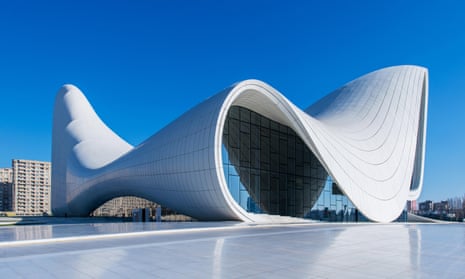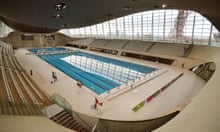The too-early death of the architect Zaha Hadid will not obliterate the floating curve from the language of architecture. She was not the first to love its beauty – see the work of Eero Saarinen, not to mention Oscar Niemeyer, the first king of the curve. Now, the seemingly impossible aerial curve and the twisted-Pringle roof line with which Hadid is identified is too loved a form to disappear from the lexicon. They were not her invention, but they are now identified with her uncompromising, demanding vision and it shapes the way we in our turn see them: seductive, voluptuous, speaking of an uncorseted ease.
The Iraqi-born designer brought her gender and her outsider status – or, as she preferred, her on-the-edge perspective – to a profession dominated by European men. But she was also both a mathematician and an extraordinary artist (as her paintings, like those for one of her first award-winning but unbuilt projects, the Peak Leisure Club, demonstrate). She had the theory and married it to an extraordinary creativity.
But as much as those qualities, it was her flamboyant personality that identified her with the rejection of what in the public imagination seemed to be an architectural aesthetic dominated by hard, straight lines and harsh, unfriendly materials. Before Hadid, architecture was a story of order and control, of spatial dominance guided more by a utilitarian virtue. In the terms of William Hogarth’s Analysis of Beauty, it had fitness and propriety but not that vital quality of intricacy, none of what he called the “wanton kind of chase” of the serpentine curve.
That was not, or not only, the failure of the almost entirely male architectural imagination. The task of turning Hadid’s ideas into reality ultimately depended on exploiting the power of computers to engineer them for which her senior partner Patrik Schumacher should get much of the credit. It was finding the algorithms that freed the three-dimensional curve from the constraints of gravity – “I can now believe in buildings that can float,” she said in one early interview – that made construction possible.
But architecture is also about selling your way of seeing; that was Hadid’s strength, in failure as in success. Ruing the failure of Welsh politicians to understand her Cardiff opera house scheme, another of the unbuilt projects of her early years, she beguilingly explained how she wanted her architecture to move through space, and to shape how space makes people move. Her best work was never only about the building, but about where and how the building was to be.
Although she often rebelled against admirers who wanted to use her gender to define her, these early works in particular feel as if they could only be the product of a particularly female imagination. She was a trailblazer for her gender – the first woman to win the Pritzker prize, the first woman to win, as an individual, Riba’s gold medal. She was rightly irritated to be described as a diva, as if leading male architects were entitled to make extreme demands on construction techniques or run over budget, while a female architect who did the same was behaving irrationally. But by the end, she began to defy sexism the way her buildings defied gravity: the appeal of her work lies partly at least in the sense that they embody a unique female personality. She will leave an extraordinary architectural legacy, and a feminist one too.








